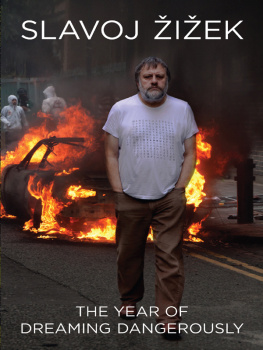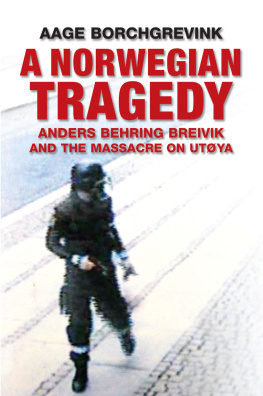
About the author
Sindre Bangstad is a Norwegian social anthropologist. He worked as an associate professor at Oslo University College from 2008 to 2010, and from 2010 to 2013 was a postdoctoral fellow at the Department of Social Anthropology, University of Oslo. He is currently an affiliate researcher at the Faculty of Theology, University of Oslo, and is the author of the award-winning book The Faces of Secularism.
ANDERS BREIVIK AND THE RISE OF ISLAMOPHOBIA
Sindre Bangstad

Zed Books
London
Anders Breivik and the Rise of Islamophobia was first published in 2014 by Zed Books Ltd, 7 Cynthia Street, London N1 9JF , UK
This ebook edition was first published in 2014
www.zedbooks.co.uk
Copyright Sindre Bangstad 2014
The right of Sindre Bangstad to be identified as the author of this work has been asserted by him in accordance with the Copyright, Designs and Patents Act, 1988
Set in Monotype Plantin and FFKievit by Ewan Smith, London NW5
Index:
Cover designed by Liam Chapple
All rights reserved. No part of this publication may be reproduced, stored in a retrieval system or transmitted in any form or by any means, electronic, mechanical, photocopying or otherwise, without the prior permission of Zed Books Ltd.
A catalogue record for this book is available from the British Library
Library of Congress Cataloging in Publication Data available
ISBN 978-1-78360-010-6
CONTENTS
IN MEMORIAM
Mona Abdinur (18), Oslo
Ismail Haji Ahmed (19), Hamar
Thomas Margido Antonsen (16), Oslo
Pamela Porntip Ardam (21), Oslo
Modupe Ellen Awoyemi (15), Drammen
Lena Maria Bergum (19), Namsos
Kevin Daae Berland (15), Asky
Trond Berntsen (51), vre Eiker
Sverre Flte Bjrkavg (28), Sula
Torjus Jakobsen Blattmann (17), Kristiansand
Carina Borgund (18), Oslo
Johannes Bu (14), Mandal/Longyearbyen
Monica Elisabeth Bsei (45), Hole
sta Sofie Helland Dahl (16), Sortland
Sondre Furseth Dale (17), Haugesund
Monica Iselin Didriksen (18), Sund
Gizem Dogan (17), Trondheim
Andreas Edvardsen (18), Sarpsborg
Tore Eikeland (21), Ostery
Bendik Rosns Ellingsen (18), Rygge
Hanne Marie Orvik Endresen (61), Oslo
Aleksander Aas Eriksen (16), Merker
Andrine Bakkene Espeland (17), Fredrikstad
Hanne Anette Balch Fjalestad (43), Lunner
Silje Merete Fjellbu (17), Tinn
Hanne Kristine Fridtun (19), Stryn
Andreas Dalby Grnnesby (17), Hamar
Snorre Haller (30), Trondheim
Kai Hauge (32), Oslo
Rune Havdal (43), vre Eiker
Ingrid Berg Heggelund (18), s
Ida Marie Hill (34), Oslo
Karin Elena Holst (15), Mo i Rana
Anne Lise Holter (51), Vler
Eivind Hovden (15), Tokke
Guro Vartdal Hvoll (18), rsta
Rafal Mohamad Jamil Jamil (20), Egersund
Steinar Jessen (16), Alta
Maria Maager Johannesen (17), Nttery
Ronja Sttar Johansen (17), Vefsn
Espen Jrgensen (17), Bod
Sondre Kjren (17), Orkdal
Margrethe Byum Klven (16), Brum
Syvert Knudsen (17), Lyngdal
Tove shill Knutsen (56), Oslo
Anders Kristiansen (18), Bardu
Jon Vegard Lervg (32), Oslo
Elisabeth Tnnes Lie (16), Halden
Gunnar Linaker (23), Bardu
Tamta Liparteliani (23), Kutaisi, Georgia
Eva Kathinka Ltken (17), Sarpsborg
Hanne Ekroll Lvlie (30), Tyristrand
Even Flugstad Malmedal (18), Gjvik
Tarald Kjuven Mjelde (18), Ostery
Ruth Benedicte Vatndal Nilsen (15), Tnsberg
Emil Okkenhaug (15), Levanger
Diderik Aamodt Olsen (19), Nesodden
Hendrik Andr Pedersen (27), Porsanger
Rolf Cristopher Johansen Perreau (25), Trondheim
Karar Mustafa Qasim (19), Vestby
Bano Abobakar Rashid (18), Nesodden
Henrik Rasmussen (18), Hadsel
Ida Beathe Rogne (17), stre Toten
Synne Ryneland (18), Oslo
Kjersti Berg Sand (26), Nord-Odal
Marianne Sandvik (16), Hundvg
Fredrik Lund Schjetne (18), Eidsvoll
Lejla Selaci (17), Fredrikstad
Birgitte Smetbak (15), Nttery
Isabel Victoria Green Sogn (17),
Oslo
Silje Stamneshagen (18), Asky
Victoria Stenberg (17), Nes
Tina Sukavara (18), Vads
Sharidyn Meegan Ngahiwi Svebakk-Bhn (14), Drammen
Simon Sb (18), Salangen
Hvard Vederhus (21), Oslo
Hkon degaard (17), Trondheim
ACKNOWLEDGEMENTS
This book has been long in the making. A great number of people in Norway were personally affected as relatives, friends or acquaintances of the seventy-seven unique human beings who lost their lives on 22 July 2011. There were no victims from my own family. Yet having for a long time had a concern with and interest in the state of Norwegian public discourses on Islam and Muslims, I realized soon after the horror of what had happened on 22 July 2011 had sunk in that I would have to write a book about it as a way of coming to terms with it both personally and professionally. What was originally conceived of as a memorial stone to those who lost their lives at Government Headquarters and at Utya gradually gestated into the book you now have in your hands.
There is a long list of people to whom I owe great thanks for their part in my intellectual and professional formation as a social anthropologist, and for their contributions to my thinking about the topic at hand, but space does not allow me to thank them all here. At Zed Books, I would like to thank Ken Barlow for taking the risk of publishing this book. Gavan Titley provided a welcome introduction to Zed. Sally Noonan in Canada and Richard Daly in Norway have contributed to improving the manuscript immeasurably along the way. My close family deserves my greatest thanks for having put up with an all too often distracted father and husband. I would like to acknowledge my debts to the following scholars, intellectuals and/or friends in Norway and elsewhere: Cora Alexa Dving, Oddbjrn Leirvik, Kathinka Frystad, Marius Linge, Mohammed Shoaib Sultan, Rune Berglund Steen, Kari Helene Partapouli, Mari Linlkken, Bengt Andersen, Olav Elgvin, Berit Thorbjrnsrud, Dag Herbjrnsrud, Kai E. Kverme, Julian Kramer, Bjrn Westlie, Christine M. Jacobsen, Jon Rogstad, Bjrn Bertelsen, Odin Lysaker, Sveinung Sandberg, Ervin Kohn, Anne Sender, Jonas Jakobsen, Lars Gule, Knut Vikr, Thomas Hylland Eriksen, Anders Juvik Rupsks, Ammar Hamdan, Yngvil Mortensen, Ulrika Mrtensson, Lena Larsen, Lars stby, Tore Rem, Arne Johan Vetlesen, Linda Alghazari, Mohammad Usman Rana, Stian Bromark, Maren Sb, Katrine Fangen, Hamzah Ahmed Rajpoot-Nordahl, Sarifa Moola-Nrnes, John Erik Fossum, Alf Jensen, Mette Kristin Stenberg, Bushra Ishaq, Mina Adampour, Michael Seltzer, Sigve Indregard, Iffit Qureshi, Gran Larsson, Mattias Gardell, Matthew Kott, Henrik Arnstad, Axel West Pedersen, Matti Bunzl, John R. Bowen, John L. and Jean Comaroff, Norman Stillman, Paul Silverstein, Gershom Gorenberg, Richard Ashby Wilson, Abdulkader I. Tayob, Aslam Farouk-Ali, Aslam Fataar, Waheeda Amien, Sadiyya Shaikh, Ralph D. Grillo, Brian Klug, Liz Fekete, Maleiha Malik, Paul Gilroy, Prakash Shah, Faisal Devji, Peter Hervik, Susi Meret, Heiko Henkel, Samuli Schielke, Yolande Jansen, Michael Sells, Fernando Bravo Lpez, Vidar Enebakk, Kaia Storvik and Joron Pihl. The usual caveats apply, and I alone bear the responsibility for any errors or inaccuracies.
PREFACE
To the extent that people associate anything with the small northern European country of Norway, terror would generally not be a term natural to associate with it. That would change on 22 July 2011, when a Norwegian right-wing extremist from the affluent western part of Oslo first set off a 950-kilo fertilizer bomb at Government Headquarters in the capital, then proceeded to the small island of Utya, some sixty kilometres north of the city, where in the course of a one-hour shooting spree he would massacre scores of teenagers attending an annual youth camp organized by the youth league of the governing social democratic Labour Party. Seventy-seven Norwegians lost their lives on that fateful day, most of them innocent teenagers who had long and fruitful lives to look forward to. It soon became clear that the culprit, the then thirty-two-year-old Anders Behring Breivik, had perpetrated these horrific acts based on a conviction that Norways social democrats were helping to turn the country into an Islamic dominion controlled by the 3.6 per cent of the countrys population who are Muslims. To Behring Breivik and his fellow ideological travellers on the extreme right, it was social democrats who, as the main party in power, had facilitated this colonization since the late 1960s, when the first mass immigration of Muslims to Norway took place. Behring Breiviks fantasies were as would become clear through analysing the cut-and-paste tract that he uploaded on the internet hours before setting out on his killing spree, and through the testimony he provided to the Oslo Magistrates Court during the ten-week trial in 2012 largely not of his own making. Yet in the aftermath of the terror attacks of 22 July 2011, the analysis of Behring Breivik and his acts of terror in Norway has more often than not tended to focus on the terrorists personality traits, rather than his ideological motivations. There is of course nothing new in this in the history of the public and intellectual rendering of acts of mass violence and terror from right-wing extremists. After the Second World War, and in the face of the documentation on the Holocaust or the Shoah, many erstwhile Nazi sympathizers in Germany and in other western European countries denied their own complicity by focusing on Hitlers alleged insanity, and they managed to convince themselves that if only they had known about
Next page










